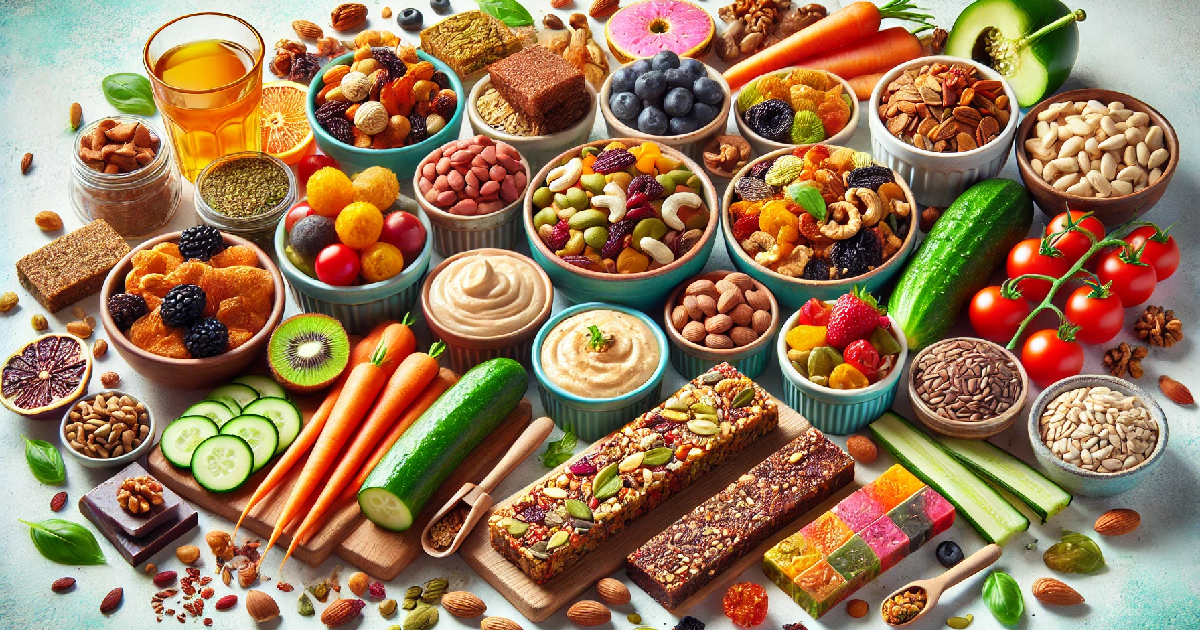Bacterial growth is a natural process that occurs everywhere in our environment. However, some environments are more conducive to bacterial growth than others. One of the factors that can influence bacterial growth is the type of food item present. Bacteria need certain nutrients and conditions to grow and multiply, and different types of food can provide varying levels of these requirements.
Food safety and hygiene are essential aspects of our daily lives. We all know that improper handling and storage of food can lead to bacterial growth and the potential for foodborne illnesses. But not all food item is made equally when it comes to fostering a bacterial growth environment. We’ll look at which foods are especially prone to bacterial growth in this blog post, along with the steps we may take to reduce the risk.
Is Food Needed For Bacterial Growth?
Yes, food is a vital requirement for bacterial growth. Like all living organisms, bacteria require a source of nutrients to survive and multiply. Food provides the necessary energy and building blocks for bacterial cells to carry out their metabolic processes. Bacteria can utilize a wide range of organic compounds found in food, such as sugars, proteins, and fats, to obtain energy and synthesize essential components for their survival. Some food items are more ideal for bacterial growth than others. For instance, moist and high-protein foods such as meat, fish, dairy products, and cooked grains provide favourable conditions for bacterial proliferation. These foods have high water activity levels that enable bacteria to thrive and multiply at a rapid rate. Factors such as moisture content, pH levels, and temperature play significant roles in determining the suitability of a food item for bacterial proliferation. By understanding and controlling these factors, we can minimize the risk of bacterial contamination and maintain food safety.
What Is Bacteria Favorite Food?
Meat, poultry, fish, eggs, dairy products, and cooked rice are all food items that are highly susceptible to bacterial growth. These foods provide the perfect environment for bacteria to thrive due to their high moisture content and nutrient-rich composition. Sugary foods like cakes or fruits with a high sugar content also encourage bacterial growth.
Raw meat is especially vulnerable to bacterial growth as it can contain harmful pathogens such as E.coli, Salmonella, and Listeria. Dairy products like milk, cheese, and yoghurt can also harbour harmful bacteria if not properly stored or pasteurized. Cooked rice is another food item that has been linked with bacterial growth due to its ability to retain moisture even after cooking.
What Are The 4 Things Bacteria Need To Grow?
The Four Things Bacteria Need To Grow Are:
- Nutrients: Bacteria require a source of nutrients to support their growth and metabolism. These nutrients include carbohydrates, proteins, lipids, vitamins, and minerals. Bacteria can utilize a wide range of organic and inorganic compounds as nutrient sources.
- Moisture: Bacteria thrive in moist environments as water is necessary for their metabolic processes and the transport of nutrients. Adequate moisture allows bacteria to dissolve and absorb nutrients from their surroundings.
- Proper Temperature: Bacteria have specific temperature ranges in which they can grow and reproduce. The ideal temperature range for most bacteria is between 68°F (20°C) and 113°F (45°C). This range is known as the mesophilic temperature range. However, there are bacteria that can grow in extreme temperature conditions, such as thermophilic bacteria that thrive at high temperatures and psychrophilic bacteria that can survive in cold temperatures.
- pH Level: The pH level of the environment plays a crucial role in bacterial growth. Most bacteria prefer a neutral pH (around 7), but some species can tolerate acidic or alkaline conditions. Bacteria have specific pH requirements based on their adaptations and the nature of their metabolic processes.
These four factors are essential for bacterial growth, and their manipulation or control is important in various fields, such as food preservation, medical settings, and environmental studies. By understanding and managing these requirements, we can effectively control bacterial growth and mitigate the risk of bacterial infections and contamination.
Does Bacteria Grow In High Protein Foods?
Bacteria can indeed grow in high protein foods, as protein-rich environments provide a favourable breeding ground for bacterial growth. High protein foods such as meats, poultry, seafood, eggs, and dairy products contain abundant nutrients that bacteria can utilize for their metabolic processes. Bacteria have the ability to break down proteins into amino acids, which serve as a source of energy and building blocks for their growth and reproduction. Additionally, the moisture content often found in protein-rich foods can create a suitable environment for bacterial proliferation. It is crucial to handle and store high protein foods properly, ensuring they are cooked thoroughly, stored at appropriate temperatures, and consumed within recommended timeframes to minimize the risk of bacterial contamination and foodborne illnesses.
What Foods Have High Bacteria?
Foods That Have A High Potential For Bacterial Contamination Include:
Raw or undercooked meats: Raw or undercooked meats, such as poultry, beef, and pork, can contain harmful bacteria like Salmonella, Campylobacter, and E. coli.
Raw seafood: Raw or improperly handled seafood, including shellfish, oysters, and sushi, can harbor bacteria like Vibrio and Norovirus.
Unpasteurized dairy products: Unpasteurized milk and dairy products can contain bacteria like Listeria, Salmonella, and E. coli.
Raw eggs: Salmonella, a pathogen that causes food poisoning, can contaminate raw or minimally cooked eggs.
Fresh produce: Bacteria can contaminate fresh fruits and vegetables through the soil, water, or handling. Contaminants such as Salmonella, E. coli, and Listeria can be found in fresh produce.
Deli meats and processed meats: Deli meats and processed meats, such as ham, turkey, and hot dogs, can sometimes be contaminated with Listeria and other bacteria during processing or storage.
What Protein Fights Bacteria?
Food safety is a major concern in today’s world, and it is crucial to understand which food items are ideal for bacterial growth. Bacteria can grow on any food item, but some foods provide perfect conditions for bacteria to thrive and multiply quickly.
Bacterial growth in food can lead to serious illnesses such as salmonella, Listeria, and E.coli infections. Understanding the factors that promote bacterial growth is essential in preventing these diseases from occurring. Factors such as temperature, moisture content, acidity levels, and nutrient availability all play a significant role in determining which foods are most likely to harbour dangerous bacteria.
How Fast Can Bacteria Grow?
Bacteria can grow at an alarming pace, with some species capable of doubling their population in as little as 20 minutes. The speed at which bacteria multiply depends on various factors such as temperature, moisture, and pH levels. In general, the ideal conditions for bacterial growth are warm and moist environments with a neutral or slightly acidic pH level.
Foods that provide optimal conditions for bacterial growth include high-protein items like meat, poultry, fish, eggs and dairy products. These foods are prone to contamination if not handled properly during storage or preparation. After purchase or cooking, they must be refrigerated immediately to prevent the proliferation of harmful bacteria such as Salmonella and E. coli.
Moreover, other types of food also support the rapid multiplication of bacteria, including cooked grains such as rice and pasta; fresh fruits and vegetables; canned goods; bakery items like bread and cakes; and starchy foods like potatoes. To prevent bacterial growth in these food items, it is essential to store them correctly at appropriate temperatures, either in a fridge or freezer, depending on the type of food item. Additionally, reheating leftovers thoroughly will ensure any remaining bacteria are destroyed before consumption.
How Can I Make Bacteria Grow Faster?

The ideal food item for bacterial growth varies depending on the type of bacteria. However, in general, most bacteria thrive in a moist and nutrient-rich environment. Foods contain protein, such as meat, fish, poultry, dairy products, and eggs, provide an excellent source of nutrients for bacterial growth. Carbohydrates such as bread and pasta also provide ample amounts of energy to support bacterial growth.
To make bacteria grow faster, it is important to create a favourable environment. This can be achieved by maintaining optimal temperature and pH levels. Most bacteria grow best in temperatures ranging between 20°C to 45°C. Most bacteria prefer pH 6.5–7.5.
Another factor that can help with faster bacterial growth is oxygen availability. Aerobic bacteria require oxygen, while anaerobic bacteria do not need it at all or cannot tolerate it. Providing adequate oxygenation will promote rapid growth of aerobic bacteria.
Overall, creating a conducive environment with proper nutrients, temperature range, pH level, and oxygen supply is key when trying to make bacteria grow faster.
What Kills Bacteria On Body?
Bacteria can grow on a wide range of surfaces, including the human body. However, the body has several defence mechanisms to kill or eliminate these harmful bacteria. One of the primary methods is through our immune system, which generates specialized cells and proteins that work to identify and destroy bacterial invaders. The skin also serves as an important barrier against bacterial infections by creating a physical barrier that prevents bacteria from entering the body.
In addition to these natural defences, certain hygiene practises, such as frequent hand washing, can aid in inhibiting bacterial proliferation in the body. Antibacterial agents found in soaps and other cleaning products can also be effective at killing bacteria on the skin’s surface. However, it’s important to note that overuse of antibacterial products could lead to antibiotic resistance. Our bodies will have a harder time fighting off infections in the future.
Regarding food items ideal for bacterial growth, certain foods are more prone than others due to their moisture content and nutrient composition. For example, high-protein foods like meat and dairy products provide an ideal environment for bacteria growth if not stored properly. Similarly, cooked grains and left at room temperature, starchy crops like potatoes can quickly grow bacteria. To minimize bacterial growth on food items, it’s important to store them properly in sealed containers at appropriate temperatures (below 40°F or above 140°F) and discard any leftovers within a few days of preparation.
What Kills Bacteria Naturally?
Bacteria thrive in warm, moist environments, and a variety of foods can provide this ideal environment for growth. Foods containing highly protein, such as meat, fish, poultry, eggs and dairy products, are particularly susceptible to bacterial growth if not handled properly. Additionally, starchy or sugary foods like breads, pastries and fruits can also harbour bacteria.
When it comes to killing bacteria naturally, there are several options available. Utilising heat is one of the most efficient methods. Cooking food at high temperatures kills off bacteria that may be present on its surface or inside. Similarly, boiling water before consumption ensures any harmful bacteria present in it are destroyed.
Another natural way to kill bacteria is through the use of certain herbs and spices known for their antimicrobial properties. Garlic and ginger have antibacterial properties against a variety of bacterial strains, while oregano oil is effective against E. coli and salmonella. Incorporating these ingredients into meals can help reduce the risk of bacterial contamination while also adding flavour to your dishes.
What pH Kills Bacteria?
The optimal food for bacterial proliferation is one with a pH level between 7.0 and 7.5. This includes meat, poultry, seafood, dairy products, and eggs. These foods provide the perfect environment for bacteria to thrive and replicate quickly.
When it comes to killing bacteria, different pH levels can have varying effects. Most bacteria prefer a neutral pH level like those found in common food items. However, environments with a pH below 4.6 can inhibit the growth of numerous varieties of bacteria and even eradicate certain strains.
On the other hand, alkaline environments with a high pH above 8.5 are also effective at killing certain types of bacteria due to their harsh conditions that disrupt cell walls and denature proteins essential for bacterial survival. Ultimately, the most effective method for killing bacteria depends on the type of microbe being targeted and its specific environmental requirements, which may vary from organism to organism.
What Kills Bacteria In Food?
Bacteria can develop in all foods, but certain foods are more susceptible than others. Bacteria grow on moist, protein-rich foods, such as meat, dairy products, eggs, seafood, and cooked cereals. The temperature of the food also plays a crucial role in bacterial proliferation.
There are various methods to kill bacteria in food. One of the most effective methods is cooking or heating food to a specific temperature for a specific amount of time. Meats, for example, should be cooked to an internal temp of 165°F (or 74° C) to kill harmful pathogens such as Salmonella and E. coli. Commonly used to eliminate microorganisms in milk and other dairy products, pasteurisation is a common method.
Chemical methods can also be used for killing bacteria in food. Commonly used chemicals include chlorine compounds like bleach or quaternary ammonium compounds (QAC), which can be found in cleaning solutions used by restaurants and kitchen facilities.
Overall, proper handling and storage of food items, along with cooking or chemical treatment, are essential steps to prevent bacterial growth and ensure safe consumption.
What Prevents The Growth Of Bacteria?
Bacteria thrive in environments that are warm, moist and have plenty of nutrients. As such, foods that are high in protein, carbohydrates and fats are ideal for bacterial growth. This includes meat, dairy products, cooked rice, potatoes and other starchy vegetables.
However, there are various variables that can inhibit bacterial development. The control of temperature regulation is one of the most crucial. Bacteria cannot survive at temperatures below 0°C or above 60°C, therefore, storing perishable items in the refrigerator and heating them to a safe internal temperature can help to reduce the risk of contamination.
Another key factor is acidity. Many bacteria require a neutral pH level to grow, but some species can only thrive in alkaline or acidic conditions. By adjusting the pH with ingredients like vinegar or lemon juice, it’s possible to inhibit the growth of harmful bacteria while preserving flavour and texture. Finally, good hygiene practices, including frequently washing hands and utensils, can help minimise the transfer of bacteria from one food item to another.
Can Protein Spread Bacteria?

It is a known fact that proteins are essential for our body’s growth, repair and maintenance of tissues. But can protein spread bacteria? The answer is yes, it can. In fact, any product with a high protein content has the potential to become a breeding habitat for bacteria if not properly stored or cooked.
Foods like meat, eggs, dairy products and seafood are rich in protein and require special attention when handling and cooking. Raw meat can contain harmful bacteria like Salmonella or E.coli, which can cause serious illnesses. Similarly, unpasteurized dairy products like cheese or milk may contain Listeria, which can lead to severe infections.
To avoid bacterial growth in protein-rich foods, it is important to store them at the right temperature and cook them thoroughly before consumption. Washing hands frequently while handling these foods and using separate cutting boards for raw meats can also prevent the spread of harmful bacteria.
How Do Bacteria Get Nutrients To Grow?
Bacteria require different nutrients to grow, including carbohydrates, proteins, and lipids. Carbohydrates are an important ingredient for bacterial development because they provide energy. Bacteria use glucose and other carbohydrates to make ATP, which powers biological functions. Proteins are another essential nutrient for bacteria since they contain amino acids that can be used to synthesize new proteins or generate energy through the process of gluconeogenesis.
Lipids also play an important role in bacterial growth since they form the structural components of the cell membrane. Bacteria need a variety of fatty acids and phospholipids to construct their membranes and maintain their integrity. In addition to these macronutrients, bacteria also require trace amounts of minerals such as iron, zinc, and calcium.
Bacterial growth requires specific conditions that promote the availability of nutrients, such as temperature, pH levels, oxygen concentration and water activity. Food items with high protein content, like meat products, provide ideal conditions for bacterial growth due to high levels of amino acids, which support bacterial metabolism, while sugary foods provide a suitable environment for yeast or fungi development rather than bacteria. The moisture present in food items also supports microbial life, making it important to store food in cool, dry places or refrigerated at low temperatures below 40°F (4°C)to minimize microbial activities that may lead to spoilage or contamination with pathogenic microorganisms that cause foodborne illness.
Conclusion:
In conclusion, it is clear that certain food items are ideal for bacterial growth. These include foods that are high in moisture content, such as fruits and vegetables, dairy products, and meat. In particular, raw or undercooked meat poses a significant risk for the growth of harmful bacteria like Salmonella and E. coli.
It is important to note that proper handling and storage of these food items can significantly reduce the risk of bacterial growth. This includes cooking meats thoroughly to kill any potential bacteria, storing refrigerated foods at a safe temperature below 40°F (4°C), and washing fruits and vegetables before consumption.
Overall, understanding which food items are ideal for bacterial growth is essential for maintaining good health and preventing foodborne illnesses. We can guarantee that our meals are both nutritious and safe to eat by being aware of potential dangers and taking proper care while handling food.

























